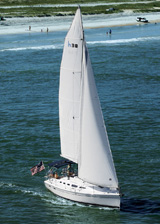Florida is a state located in the southeastern region of the United States, bordering Alabama to the northwest and Georgia to the north. Most of the states land mass is a large peninsula with the Gulf of Mexico to the west, and the Atlantic Ocean to the east. It is nicknamed the "sunshine state" because of its tropical to subtropical climate.
History
Florida was inhabited for thousands of years before any European settlements. Of the many indigenous peoples, the largest known were the Ais, the Apalachee, the Calusa, the Timucua and the Tocobago tribes.
"Florida" is the oldest surviving European place-name in the U.S. Juan Ponce de León, a Spanish explorer, named Florida in honor of his discovery of the land on the evening April 2, 1513, six days after Easter and still during Pascua Florida, a Spanish term for the "Flowery Easter" season, and for the land's appearance as a "flowered land."
Over the following century, both the Spanish and French established settlements in Florida, with varying degrees of success.
The area of Spanish Florida diminished with the establishment of English colonies to the north and French colonies to the west. The English weakened Spanish power and attacked St. Augustine, burning the city and its cathedral to the ground several times.
The Spanish, meanwhile, encouraged slaves to flee the English-held Carolinas and come to Florida, where they were converted to Roman Catholicism and given freedom. They settled in a buffer community north of St. Augustine, called Gracia Real de Santa Teresa de Mose, the first completely black settlement in what became the United States.
Great Britain gained control of Florida diplomatically in 1763 through the Peace of Paris. The British divided the colony into East Florida, with its capital at St. Augustine, and West Florida, with its capital at Pensacola. Britain tried to develop the Floridas through the importation of immigrants for labor, including some from Minorca and Greece, but this project ultimately failed. Spain regained the Floridas after Britain's defeat by the American colonies and the subsequent Treaty of Versailles in 1783, continuing the division into East and West Florida. They offered land grants to anyone who settled in the colonies, and many Americans moved to them.
Spain ceded Florida to the United States in exchange for the American renunciation of any claims on Texas and $5 million. As settlement increased, pressure grew on the United States government to remove the Indians from their lands in Florida. In 1832, the United States government signed the Treaty of Payne's Landing with some of the Seminole chiefs, promising them lands west of the Mississippi River if they agreed to leave Florida voluntarily. Many of the Seminoles left at this time, while those who remained prepared to defend their claims to the land. White settlers pressured the government to remove all of the Indians, by force if necessary, and in 1835, the U.S. Army arrived to enforce the treaty.
Even after three bloody wars, the U.S. failed to force all of the Seminole Indians in Florida to the West.[12] Though most of the Seminoles were forcibly exiled to Creek lands west of the Mississippi, hundreds, including Seminole leader Aripeka (Sam Jones), remained in the Everglades and refused to leave the native homeland of their ancestors. Their descendants remain there to this day.
On March 3, 1845, Florida became the 27th state of the United States of America. Its population grew slowly. White settlers continued to encroach on lands used by the Seminoles, and the United States government resolved to make another effort to move the remaining Seminoles to the West. The Third Seminole War lasted from 1855 to 1858, and resulted in the removal of most of the remaining Seminoles. White settlers began to establish cotton plantations in Florida, which required numerous laborers. By 1860 Florida had only 140,424 people, of whom 44% were enslaved. There were fewer than 1000 free people of color before the Civil War.
On January 10, 1861, before the start of the American Civil War, Florida declared its secession from the Union; ten days later, the state became a founding member of the Confederate States of America. The war ended in 1865. On June 25, 1868, Florida's congressional representation was restored. After Reconstruction, white Democrats succeeded in regaining power in the state legislature. In 1885 they created a new constitution, followed by statutes through 1889 that effectively disfranchised most blacks and many poor whites over the next several years. Provisions included poll taxes, literacy tests, and residency requirements. Disfranchisement for most African Americans in the state persisted until the Civil Rights Movement of the 1960s gained federal legislation to protect their suffrage.Reports on harbors and marinas in Florida can be found here
Weather for Fort Lauderdale within the Yacht Charter Area of Florida














